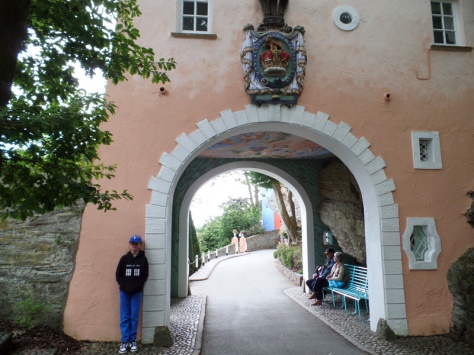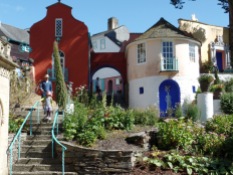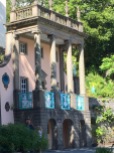
Ciao! Welcome to Fifteenth Century Italy – otherwise known as Portmeirion in July 2015! We are travelling back in time to last summer to visit North Wales for the filming location of the Tom Baker Doctor Who episode The Masque of Mandragora (1976).
In this classic episode, The Fourth Doctor and Sarah Jane materialise the TARDIS in an orange grove on Earth in the 15th Century, which the Doctor describes as
‘not a pleasant time’.
They are in San Martino, Italy in 1492 and have brought a piece of energy from the Mandragora Helix with them by accident! This story is a historical drama which was rare for Doctor Who at that time.

Portmeirion is located in area of Wales called Gwynedd and is near Porthmadog. It was designed and built by the architect Sir Clough Williams-Ellis in the style of an Italian village, and it is now a tourist village. Work started in 1925 and it took 50 years for him to build this village but it was finished just before he died. He built it to show how you can develop a naturally beautiful site without ruining it. If you would like to find out more about the history of Portmeirion please check out this excellent blog post A Very Brief History of Portmeirion Village.
Apart from Doctor Who, Portmeirion has served as the location for many films and television shows, and is very well known as the filming location for the 1960s television show The Prisoner. It is also famous for pottery – in fact my own plates are made by Portmeirion Pottery from the Botanic Garden range .
I visited Portmeirion during my Welsh road-trip of 2015 and it was my first Northern Wales stop – the weather was very sunny which showed off the colours of Portmeirion and it looked very cheerful.
In The Masque of Mandragora DVD extra ‘Secret of the Labyrinth’ (the original name for this episode) the episode Producer Philip Hinchcliffe said that he had been to Portmeirion many years before and that the writer Louis Marks had studied Renaissance Italy at Oxford. They couldn’t go abroad to film this episode but Portmeirion stepped up!

Production Manager Chris D’Oyly-John thought it was good news that they had a location but a lot of time and money was spent travelling back and forth between London and North Wales. With travelling the shoot would take 5 or 6 days and there were no motorways. It was hard to get horses, props, costumes and make-up vans there.
To keep it looking like 15th Century Italy the Director Rodney Bennett did very selective shooting and not many panoramic movements. He used the Italianate backgrounds and covered up bits that didn’t look right for the period. A fake catacomb entrance was made to link the studio scenes with Portmeirion.

There is also a DVD extra, produced by Richard Bignell, called Now and Then. It says that in a memo, written on 03.01.76, Philip Hinchcliffe said:
‘The only suitable location for exterior location filming is Portmeirion in North Wales’.
Filming started on the 3rd of May 1976 and lasted three days. In three months it will be the 40th Anniversary!
The DVD extra shows us a map the places that were used for filming. I didn’t get to visit the woods but I visited everywhere else in the village.
The first stop was the Bridge House which was used as the City Gate when Count Federico returns to San Martino. He also passes the Pantheon.
Battery Square was used for the market scene when the Doctor was on the run from the soldiers. Hangings were used to hide the bits that didn’t look suitable. There was no market when I was there, it was all set.
The Doctor passes The Loggia which houses a big Golden Buddha.
The Doctor, Sarah Jane and Giuliano scurry along the Bristol Colonnade on their way to the Temple Ruins.
In the Piazza there is a gloriette facing the ornamental pond. The Doctor is brought there to be executed but luckily tricked the executor to get away. It’s not a real building, it is just a façade. Rugs covered the iron work in the same way the hangings were used.
The Doctor rode a horse past the Hercules Hall and jumps the balustrade and steps on his way to the woodlands.

Between Neptune and Trinity Cottages, the Doctor is chased, past the Watchhouse and Belltower down towards the beach.
Clough Williams-Ellis liked the look of the ruins Temple of Demnos and asked the BBC to leave them. Sadly they were made of polystyrene!
Jim Sangster, a TV Historian said
‘…..we know it’s Portmeirion, but actually when you are watching it I don’t think that distracts, I don’t think it gets in the way at all. I’m absolutely convinced they went to Italy as far as I’m concerned’
which proves that Portmeirion was the most convincing place to film The Masque of Mandragora!

Portmeirion is a calm, tranquil and cool place to visit and is worth the travel. My favourite part was paddling in the pool in the Piazza – I was lucky that it was sunny that day because it is Wales which is a very rainy country. I hope that it will be bright for you too if you go.

In other news, I am VERY peeved about the latest Doctor Who news – Steven Moffat is quitting and there will be no new series to watch in 2016! I guess I will just have to watch some old episodes instead – there are lots for me to watch still so at least I have that to look forward to. What do you think of this news? Please leave a comment and let me know.
Thank you for reading my post, I have another classic location to tell you about next.
Arrivederci!
































Hii nice reading your blog
LikeLike